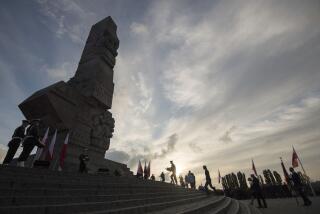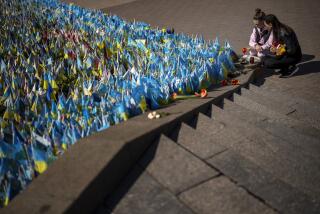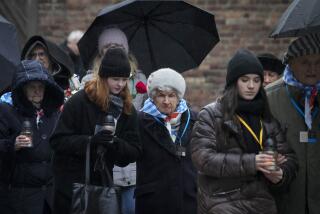Crowds Weep Over Bodies of Soviet Attack Victims
VILNIUS, Soviet Union â Somberly and by the thousands, they waited patiently as the snow fell here Monday to honor Loreta Asanaviciute, a young woman who had tried to stop a tank with her body; Ignas Simulionis, 17, whose dream was to be a doctor, and the others.
The line twisted and turned, doubled back on itself and ran up the block to a traffic light before turning right and disappearing in the distance.
Inside the Vilnius Palace of Sport, an indoor arena that had now become a place of mourning, Lithuanians slowly filed by 10 open wooden coffins, each holding the body of someone who died in the Soviet armyâs Sunday attack on the Vilnius broadcasting center and television tower.
Many people sharply drew in their breath, began to cry or shook their heads in horror. For most, news of the deaths--14 in all--had been something regrettable, even tragic, but abstract. Now they were face to face with those who died and could see the gunshot wounds some had on their faces.
At one side of the darkened hall, usually the site of basketball games and sports tournaments, a string orchestra played a solemn Bach piece. Women carefully placed carnations at the foot of the coffins. A boy carried the yellow, green and red flag of Lithuania, dipped in salute.
The parents and loved ones of the dead sat on chairs on either side of the coffins. Some spoke softly with one another, but most sat in silent grief.
They had dressed 24-year-old Loreta Asanaviciute in a spotless white gown. She worked as a sweater-knitter in a Vilnius garment factory, lived with her parents and, although she supported the cause of Lithuanian independence, had not been a political firebrand.
She had gone to the television tower last Saturday with her mother and older sister, but the three women began walking home to their apartment about half a mile short of the tower when it seemed as though the center was in no danger. But on the way they met a friend who persuaded Loreta to return with her.
The young woman with long dark hair was one of the first to meet the onslaught of Soviet armor, her family was later told.
She and other young Lithuanians had joined hands in front of a tank in an attempt to halt it, but it paused only for a moment and then sped up, breaking the human chain and running right over Loreta.
When they brought her to a Vilnius hospital, her heart and brain were still functioning, according to a family friend, speaking in a low voice to relatives at the bier. But her legs and other internal organs had been obliterated under the tankâs tread.
Before she died, she managed to tell people who she was, the friend said, so her family could be informed of her death. She was the only woman known to have died in the bloodshed.
âShe was a victim of communism,â her brother, Bronius, an engineer, said as he kept their father company by the coffin.
Black ribbons were tied on the Lithuanian flags flying from public buildings to honor the dead, and an official period of mourning was to last for three days. After a memorial service, expected to be attended by Lithuanian leaders, the dead are to be buried on Wednesday.
More to Read
Sign up for Essential California
The most important California stories and recommendations in your inbox every morning.
You may occasionally receive promotional content from the Los Angeles Times.










